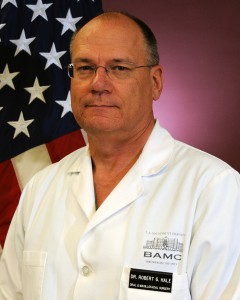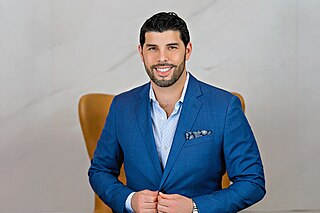Related Research Articles

Otorhinolaryngology is a surgical subspeciality within medicine that deals with the surgical and medical management of conditions of the head and neck. Doctors who specialize in this area are called otorhinolaryngologists, otolaryngologists, head and neck surgeons, or ENT surgeons or physicians. Patients seek treatment from an otorhinolaryngologist for diseases of the ear, nose, throat, base of the skull, head, and neck. These commonly include functional diseases that affect the senses and activities of eating, drinking, speaking, breathing, swallowing, and hearing. In addition, ENT surgery encompasses the surgical management of cancers and benign tumors and reconstruction of the head and neck as well as plastic surgery of the face, scalp, and neck.

Plastic surgery is a surgical specialty involving the restoration, reconstruction or alteration of the human body. It can be divided into two main categories: reconstructive surgery and cosmetic surgery. Reconstructive surgery includes craniofacial surgery, hand surgery, microsurgery, and the treatment of burns. While reconstructive surgery aims to reconstruct a part of the body or improve its functioning, cosmetic surgery aims to improve the appearance of it. A comprehensive definition of plastic surgery has never been established, because it has no distinct anatomical object and thus overlaps with practically all other surgical specialties. An essential feature of plastic surgery is that it involves the treatment of conditions that require or may require tissue relocation skills.
Oral and maxillofacial surgery is a surgical specialty focusing on reconstructive surgery of the face, facial trauma surgery, the oral cavity, head and neck, mouth, and jaws, as well as facial cosmetic surgery/facial plastic surgery including cleft lip and cleft palate surgery.

Orthognathic surgery, also known as corrective jaw surgery or simply jaw surgery, is surgery designed to correct conditions of the jaw and lower face related to structure, growth, airway issues including sleep apnea, TMJ disorders, malocclusion problems primarily arising from skeletal disharmonies, and other orthodontic dental bite problems that cannot be treated easily with braces, as well as the broad range of facial imbalances, disharmonies, asymmetries, and malproportions where correction may be considered to improve facial aesthetics and self-esteem.
Craniofacial surgery is a surgical subspecialty that deals with congenital and acquired deformities of the head, skull, face, neck, jaws and associated structures. Although craniofacial treatment often involves manipulation of bone, craniofacial surgery is not tissue-specific; craniofacial surgeons deal with bone, skin, nerve, muscle, teeth, and other related anatomy.

The Queen Victoria Hospital (QVH), located in East Grinstead, West Sussex, England is the specialist reconstructive surgery centre for the south east of England, and also provides services at clinics across the region. It has become world-famous for its pioneering burns and plastic surgery. The hospital was named after Queen Victoria. It is managed by the Queen Victoria Hospital NHS Foundation Trust.

The Le Fortfractures are a pattern of midface fractures originally described by the French surgeon, René Le Fort, in the early 1900s. He described three distinct fracture patterns. Although not always applicable to modern-day facial fractures, the Le Fort type fracture classification is still utilized today by medical providers to aid in describing facial trauma for communication, documentation, and surgical planning. Several surgical techniques have been established for facial reconstruction following Le Fort fractures, including maxillomandibular fixation (MMF) and open reduction and internal fixation (ORIF). The main goal of any surgical intervention is to re-establish occlusion, or the alignment of upper and lower teeth, to ensure the patient is able to eat. Complications following Le Fort fractures rely on the anatomical structures affected by the inciding injury.
Paul Tessier was a French maxillofacial surgeon. He was considered the father of modern craniofacial surgery.

A jaw abnormality is a disorder in the formation, shape and/or size of the jaw. In general abnormalities arise within the jaw when there is a disturbance or fault in the fusion of the mandibular processes. The mandible in particular has the most differential typical growth anomalies than any other bone in the human skeleton. This is due to variants in the complex symmetrical growth pattern which formulates the mandible.
Aesthetic medicine is a branch of modern medicine that focuses on altering cosmetic appearance through the treatment of conditions including scars, skin laxity, wrinkles, moles, liver spots, excess fat, cellulite, unwanted hair, skin discoloration, and spider veins. Traditionally, it includes dermatology, oral and maxillofacial surgery, reconstructive surgery and plastic surgery, surgical procedures, non-surgical procedures, and a combination of both. Aesthetic medicine procedures are usually elective. There is a long history of aesthetic medicine procedures, dating back to many notable cases in the 19th century, though techniques have developed much since then.
A facial cleft is an opening or gap in the face, or a malformation of a part of the face. Facial clefts is a collective term for all sorts of clefts. All structures like bone, soft tissue, skin etc. can be affected. Facial clefts are extremely rare congenital anomalies. There are many variations of a type of clefting and classifications are needed to describe and classify all types of clefting. Facial clefts hardly ever occur isolated; most of the time there is an overlap of adjacent facial clefts.
Peter James Taub, MD, FACS, FAAP, is an American Professor of Surgery, Pediatrics, Dentistry, Neurosurgery, and Medical Education at the Icahn School of Medicine at Mount Sinai as well as Attending Plastic and Reconstructive Surgeon at the Mount Sinai Medical Center and Elmhurst Hospital Center, all in New York City. He is a diplomate of both the American Board of Surgery and the American Board of Plastic Surgery.
Hermann F. Sailer is a German maxillofacial surgeon. He leads the Klinik Professor Sailer in Zurich and is the founder of the Cleft-Children International Foundation.

Colonel Robert G. Hale, DDS is an oral and maxillofacial surgeon and former Commander of the US Army Dental and Trauma Research Detachment. Hale lectures worldwide on craniomaxillofacial battle injuries and regenerative medicine. He is a researcher and public advocate for the advancement and benefits of regenerative medicine.
Hugo Obwegeser was an Austrian Oral and Maxillo-Facial Surgeon and Plastic Surgeon who is known as the father of the modern orthognathic surgery. In his publication of 1970, he was the first surgeon to describe the simultaneous procedure which involved surgeries of both Maxilla and Mandible involving Le Fort I and Bilateral Sagittal Split Osteotomy technique.
Neuroplastic or neuroplastic and reconstructive surgery is the surgical specialty involved in reconstruction or restoration of patients who undergo surgery of the central or peripheral nervous system. The field includes a wide variety of surgical procedures that seek to restore or replace a patient's skull, face, scalp, dura, the spine and/or its overlying tissues.
Andrew A.C. Heggie is an oral and maxillofacial surgeon at the Royal Children's Hospital in Melbourne, Australia. His primary interest has been the management of developmental skeletal facial deformity, including patients with cleft lip and palate, craniofacial microsomia and infants with micrognathism. His contribution to the treatment of infant upper airway obstruction for Pierre Robin sequence, using internal devices for jaw lengthening using distraction osteogenesis, has replaced the need for tracheostomy in this condition. In 2019, Heggie was awarded Member of the Order of Australia for significant service to medicine and dentistry in the field of oral and maxillofacial surgery.
Derek Steinbacher is an American cosmetic plastic, rhinoplasty, and maxillofacial surgeon who is Professor of Plastic Surgery at Yale New Haven Health in Connecticut. He is also the chief of the Dental Department and Oral and Maxillofacial Surgery at Yale New Haven Health. He is known for his clinical work, research and incorporation of 3D analysis and printing into jaw surgery, craniofacial surgery and rhinoplasty.

Adam Jeremy Oppenheimer is an American plastic surgeon and medical researcher known previously for his research in craniofacial surgery and current work in labiaplasty surgery.

Mandibular setback surgery is a surgical procedure performed along the occlusal plane to prevent bite opening on the anterior or posterior teeth and retract the lower jaw for both functional and aesthetic effects in patients with mandibular prognathism. It is an orthodontic surgery that is a form of reconstructive plastic surgery. There are three main types of procedures for mandibular setback surgery: Bilateral Sagittal Split Osteotomy (BSSO), Intraoral Vertical Ramus Osteotomy (IVRO) and Extraoral Ramus Osteotomy (EVRO), depending on the magnitude of mandibular setback for each patient. Postoperative care aims to minimise postoperative complications, complications includes bite changes, relapse and nerve injury.
References
- 1 2 American Society of Maxillofacial Surgeons
- 1 2 Cohen SR, Juhala CA, Manson PN, Crawley WA, Jacobs JS. History of the American Society of Maxillofacial Surgeons: 1947-1997. Plastic and Reconstructive Surgery. 1997 Sep;100(3):766-801.
- ↑ Yu, Kumar, and Lin. "Celebrating Our Proud Heritage – 75th Anniversary of the ASMS". The American Society of Maxillofacial Surgeons. Retrieved 17 June 2022.
{{cite web}}: CS1 maint: multiple names: authors list (link) - ↑ Yu JC, Lin AY (June 2022). "American Society of Maxillofacial Surgeons: The Last 25 Years and the Next 25 Years". FACE. doi:10.1177/27325016221103064. S2CID 249801530 . Retrieved 17 June 2022.
- 1 2 Cohen MN, Evans GR, Wexler A, Thaller SR, Sadove AM. American Society of Maxillofacial Surgeons, 1997 to 2006: another decade of excellence in education and research. Plastic and Reconstructive Surgery. 2006 Oct.; 118 (5 Suppl): 32S-42S.
- ↑ "FACE Homepage". FACE. SAGE Journals. Retrieved 17 June 2022.
- ↑ "FACE podcast on SAGE Clinical Medicine & Research". SAGE Clinical Medicine & Research. SAGE Journals. Retrieved 23 May 2023.
- ↑ O'Dowd and McMahon (February 11, 2021). "Doctor Who Performed World's 1st Successful Face, Double Hand Transplant Discusses Rare Surgery". WBUR Here & Now. Retrieved 17 June 2022.
- ↑ Pietsch, Bryan (August 1, 2020). "Connie Culp, First Face Transplant Recipient in U.S., Dies at 57". New York Times. Retrieved 17 June 2022.
- ↑ Kessel, Mcniff, and Effron (September 27, 2018). "Youngest US face transplant recipient shares story of suicide survival and hope: 'Life is an amazing gift'". ABC News. Retrieved 17 June 2022.
{{cite news}}: CS1 maint: multiple names: authors list (link)